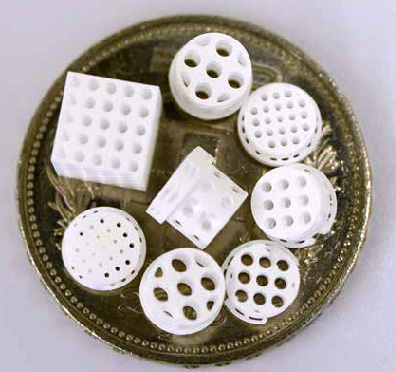Cranio Maxillofacial Surgery
Head
Prof. Harald Essig MD, DMD
Director Department of
Cranio-Maxillofacial Surgery
Organization
Research in the Department of Cranio-Maxillofacial Surgery covers head and neck oncology, computer assisted surgery, photodynamic therapy, and oral biotechnology & bioengineering.
The projects of the latter one are epigenetic active small chemicals to be applied for bone regeneration, treatment of bone defects in inflammation-compromised situations, adiposity, and even male contraception.
The other major field of oral biotechnology & bioengineering is additive manufacturing of bone substitutes with the final aim to provide our patients with osteoconductive bone substitutes from calcium phosphate and Bioglass, and to realize the use of personalized bone substitutes for our patients.

Figure 1 Diverse calcium phosphate-based bone substitutes produced by additive manufacturing (Ghayor & Weber FE (2018); Frontiers in Physiology doi: 10.3389/fphys.2018.00960)
The project on additive manufacturing of bone substitutes is funded by the Swiss National Science Foundation and includes partners from the University of Applied Science (Muttenz, Switzerland) and the PolyU (Hong Kong). After we have unraveled the microarchitecture of lattice structures and pore-based structures to yield in accelerated bone ingrowth and defect bridging, we now shift towards a better understanding of the biology of osteoconduction as a major driving force for bone regeneration and repair.
A third project of oral biotechnology & bioengineering is funded by a Bundesstipendium and deals with the preservation and regeneration of the pulp to keep teeth alive, to postpone tooth loss, and replacement by dental implants.

Figure 2: Bony bridging realized by an optimal osteoconductive microarchitectures for a 6 mm defect in 4 weeks. (Bone blue; scaffold black). (Ghayor & Weber FE (2018); Frontiers in Physiology doi: 10.3389/fphys.2018.00960)
Computer assisted surgery is another focus in our department. Here we want to optimize the digital planning of operations and move on towards automation of planning and quality control. Finally, we want to offer our patients patient-specific implants and osteosynthesis materials.

Figure 3: Conventional (a) and additively manufactured (b) microarchitecture of bone substitutes. For additively manufactured bone substitutes, the microarchitecture in terms of pore location and connections between pores (B: bottleneck) is well defined. (Pores are grey and the scaffold dark blue). (Ghayor & Weber FE (2018); Frontiers in Physiology doi: 10.3389/fphys.2018.00960).
Photodynamic therapy is a promising treatment for medication-related osteonecrosis of the jaw (MRONJ). MRONJ is a severe adverse drug reaction, manifested in a progressive irreversible bone destruction in the maxillofacial region, associated with discomfort and pain for the patients.
Collaborations
- University of Applied Sciences Northwestern Switzerland, School of Life Sciences, Institute for Medical and Analytical Technologies (Prof. Michael de Wild).
- Department of Fixed and Removable Prothodontics and Dental Material Science, University of Zurich, Switzerland(Prof. Ch. Hämmerle, Prof. Dr. Ronald Jung, PD Dr. Daniel Thoma).
- Division of Preventive Dentistry, Periodontology, and Cariology, University of Zurich Center of Dental Medicine, Zurich, Switzerland (Prof. T. Attin, Prof. M. Zehnder, Prof. P. Schmidlin).
- Department of Masticatory Disorders, University of Zurich, Switzerland (Prof. L. Gallo)
- Division of Obstetrics (Prof. R. Zimmermann, Dr. Martin Ehrbar)
- ETH Zurich, Cartilage Engineering + Regeneration (Prof. M. Zenobi-Wong)
- Universität Hongkong, Prof. R. Zwahlen.
- UZH, Biochemistry, Prof. Amedeo Caflisch
- Biolitec research GmBH, Jena, Germany
- Orcos Medical, Küsnacht, Switzerland
- University of Zurich, Center of Dental Medicine, Division of Preventive Dentistry, Periodontology, and Cariology, Zurich,Switzerland (Prof. T. Attin, Dr. T. Thurnheer)
- University of Zurich, Institute of Anatomy (Prof. C. Maake)
- ETH Zurich, Department of Health Sciences and Technology, Institute for Biomechanics, Laboratory for Bone Biomechanics Zurich, Switzerland (Prof. R. Müller)
- University of Zurich, Department of Chemistry, Zurich, Switzerland (Prof. G. Patzke)
- University Hospital of Zurich, Department of Infectious Disease and Hospital Epidemiology, Zurich, Switzerland (Prof. A. Zinkernagel)
